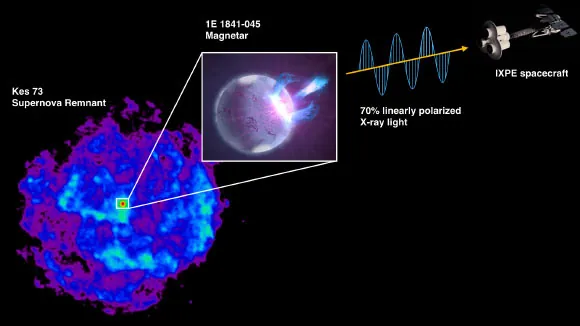
Unveiling the Mysteries of Magnetars: IXPE Measures X-ray Polarization During a Stellar Outburst
2025-06-06
Author: Yu
What Are Magnetars?
Magnetars are among the universe's most enigmatic entities—neutron stars with magnetic fields that are a staggering quadrillion times stronger than Earth's. Formed from the collapse of massive stars, these compact giants not only emit intense bursts of X-rays but also exhibit unpredictable activity patterns that can unleash energy millions of times greater than our Sun produces in an entire year.
A Historic Observation by IXPE
Astronomers utilized NASA’s Imaging X-ray Polarimetry Explorer (IXPE) to observe the magnetar 1E 1841-045, located around 28,000 light-years away in the Kes 73 supernova remnant. This groundbreaking mission enabled scientists to take the first-ever polarization measurements of a flaring magnetar, as documented in two studies published in the Astrophysical Journal Letters.
The Nature of Magnetar Outbursts
On August 21, 2024, the 1E 1841-045 magnetar was spotted in an outburst by NASA's Swift, Fermi, and NICER telescopes. Outbursts occur when the magnetar’s magnetic fields undergo disturbances, causing it to emit X-rays—sometimes up to a thousand times more energy than its typical emission for several weeks. The exact mechanisms driving these explosive events remain a mystery, which is why IXPE's observations are so crucial.
The Power of Polarization Measurements
IXPE's polarization measurements offer critical insights into the orientation and synchronization of emitted X-ray waves. The more tightly the waves travel in sync, akin to a perfectly coordinated dance, the higher their degree of polarization. This allows researchers to glean information about the energetic processes responsible for the observed photons and the geometrical layout of the magnetar's magnetic field.
Key Findings from IXPE's Observations
The IXPE findings, supported by additional data from NASA's NuSTAR and NICER telescopes, reveal that the X-ray emissions from 1E 1841-045 become increasingly polarized at higher energy levels while maintaining a consistent direction of propagation. Notably, this high degree of polarization is significantly influenced by the hard X-ray tail—the energetic component that dominates the highest photon energies observed.
A Step Forward in Understanding High-Energy Emissions
Despite their prevalence in magnetars, the mechanisms behind the production of these high-energy X-ray photons remain largely unclear. However, the recent high polarization linked to these emissions will inform and refine existing models, giving scientists a clearer view of magnetar dynamics. Rachael Stewart, a Ph.D. student and lead author of one of the studies, stated, "This unique observation enhances our understanding of magnetar hard X-ray emissions and highlights the importance of polarization measurements in extreme astrophysical conditions."
Looking Ahead
As researchers eagerly await the next phase of observations—when 1E 1841-045 returns to its quieter state—the potential to track changes in its polarimetric properties poses exciting opportunities for further groundbreaking discoveries.




 Brasil (PT)
Brasil (PT)
 Canada (EN)
Canada (EN)
 Chile (ES)
Chile (ES)
 Česko (CS)
Česko (CS)
 대한민국 (KO)
대한민국 (KO)
 España (ES)
España (ES)
 France (FR)
France (FR)
 Hong Kong (EN)
Hong Kong (EN)
 Italia (IT)
Italia (IT)
 日本 (JA)
日本 (JA)
 Magyarország (HU)
Magyarország (HU)
 Norge (NO)
Norge (NO)
 Polska (PL)
Polska (PL)
 Schweiz (DE)
Schweiz (DE)
 Singapore (EN)
Singapore (EN)
 Sverige (SV)
Sverige (SV)
 Suomi (FI)
Suomi (FI)
 Türkiye (TR)
Türkiye (TR)
 الإمارات العربية المتحدة (AR)
الإمارات العربية المتحدة (AR)